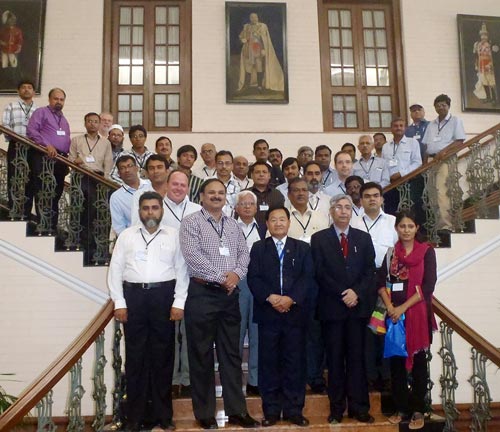 Scientists from the Heat Stress Tolerant Maize for Asia (HTMA) project and representatives from collaborating public and private sector institutions from the region, Purdue University, and CIMMYT gathered together during 30-31 July 2013 in Kathmandu, Nepal, for the 1st HTMA Annual Progress Review and Planning Meeting. The meeting was jointly organized by the National Maize Research Program (NMRP) and CIMMYT to discuss progress to-date and future HTMA work plans. HTMA, supported by USAID under the Feed the Future initiative, is a public-private alliance targeting resource-poor people in South Asia who rely on growing maize for subsistence or income in rainfed conditions and whose welfare is directly dependent on maize yields and negatively affected by crop failures.
Scientists from the Heat Stress Tolerant Maize for Asia (HTMA) project and representatives from collaborating public and private sector institutions from the region, Purdue University, and CIMMYT gathered together during 30-31 July 2013 in Kathmandu, Nepal, for the 1st HTMA Annual Progress Review and Planning Meeting. The meeting was jointly organized by the National Maize Research Program (NMRP) and CIMMYT to discuss progress to-date and future HTMA work plans. HTMA, supported by USAID under the Feed the Future initiative, is a public-private alliance targeting resource-poor people in South Asia who rely on growing maize for subsistence or income in rainfed conditions and whose welfare is directly dependent on maize yields and negatively affected by crop failures.
K.B. Koirala, National Maize Coordinator for Nepal, welcomed all participants and highlighted the importance of the public-private alliance through HTMA, especially for addressing such complex issues as developing and distributing heat stress resilient maize. CIMMYT Global Maize Program director B.M. Prasanna reiterated the need for and importance of maize breeding for heat-stress resilience in his opening remarks, while USAID’s Larry Beach stressed the project’s significance in addressing the emerging effects of climate change.
The first day was devoted to an annual progress review, which was initiated by senior maize physiologist and CIMMYT and HTMA project leader P.H. Zaidi, who presented updates on the project execution and status of progress during the project’s first year. The following session, chaired by Nepal Agricultural Research Council (NARC) executive director D.B. Gurung, covered membrane lipid profiling in relation to heat stress; identifying quantitative trait loci (QTL) for heat-stress tolerance and component traits by joint linkage analysis; association mapping for heat tolerance; latest marker statistics on genotyping-by-sequencing; genomic selection for heat stress tolerance; and development of target populations for rapid-cycle genomic selection. The afternoon session was chaired by Pakistan Agricultural Research Council (PARC) chairman Iftikhar Ahmad and focused on phenotyping for heat-stress tolerance; crop modeling and the IMPACT model component; a road map for development and distribution of heat resilient maize; seed distribution systems; and seed companies’ perspectives on target markets.
During day two, participants discussed and developed a workplan and activities for the second year of the project for each collaborating institution. This was followed by a special session on “Exploring linkages & synergy among USAID-funded projects in South Asia.” Representatives from various ongoing projects in the region, including the Hill Maize Research Project (HMRP), Cereal System Initiative for South Asia (CSISA), and HTMA, as well as NARC and the Nepalese Ministry of Agriculture, joined in the lively discussion, which helped to identify opportunities for potential linkages among the region’s initiatives and a synergy between them. The linkages could offer a win-win situation for all stakeholders.
The meeting was concluded with an HTMA project steering committee meeting chaired by B.M. Prasanna. The committee members expressed their satisfaction with the strategy, ongoing activities, and the progress being made.
 Climate adaptation and mitigation
Climate adaptation and mitigation 
